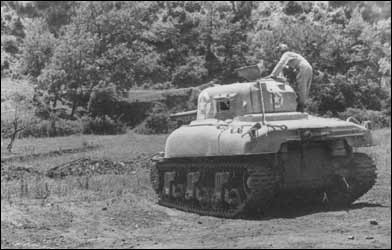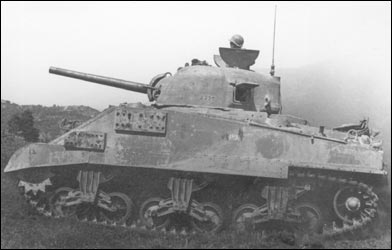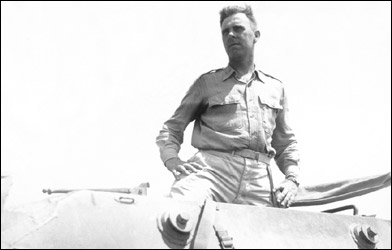752nd
Tank Battalion's Role in the
Armored Training School
 |
The 752nd Tank Battalion played a little known, but highly important role in training tank crews and officers for use throughout North Africa, Sicily, and Italy.
By February 1943, the British component of the joint British-American 18th Army Group in North Africa had developed a system which they considered highly effective in replacing tanks and crews lost in combat. Prior to the establishment of this system, the British, like the Americans, replaced tanks in either of two circumstances. First, the new or repaired tanks were drawn from Ports, Base Depots, or Workshops. The second circumstance was to repair the tanks in the field and redistribute them within the armored unit.
Either circumstance posed serious logistical challenges. The tanks had to be thoroughly checked, filled with ammunition, and provided with trained crews prior to going into battle. There was also the problem of training reinforcement personnel and organizing them into complete and cohesive crews. It was generally impractical for all this to be done at the individual unit level, or with any degree of speed.
The British First and Eighth Armies in the 18th Army Group addressed this problem in North Africa by setting up an organization known as the Tank Reorganization Group. This unit was located in the railhead area and its main functions were to:
Further forward in the Corps area, each Corps was given a Delivery Squadron, whose function was to:Service and repair the tanks sent from Base
Furnish the tanks with complete crews
Provide intense training in gunnery, operating, driving, and maintenance
On 26 February 1943, Major General R. L. McCreery, Chief General Staff of the 18th Army Group, sent a memorandum to the Chief of Staff of the Allied Force Headquarters, strongly recommending that the U.S. II Corps set up a similar system as soon as possible. McCreery further recommended that the new replacement organization be formed from "one of the General Headquarters Tank Battalions now in Fifth Army and which I understand has no equipment at present." Though he did not specifically refer to the 752nd Tank Battalion by name in this memo, the 752nd was in fact the only Fifth Army tank battalion without full equipment strength. Further, Lt. Col. Bruss of the 752nd Tank Battalion was the only other individual copied on this memo.Sort crews of tanks that had become battle casualties in order to ensure that they return to their former units rather than be redistributed to other armored units (considered highly important for esprit de corps and morale)
Conduct final preparation of the repaired or replaced tanks in formation workshops prior to returning to battle
On 17 March 1943 the 752nd Tank Battalion was inactivated and redesignated as the 2642nd Armored Replacement Battalion. The orders were issued through NATOUSA Headquarters by command of General Eisenhower, and was sent to the Commanding General of the Fifth Army. The orders authorized a strength of 241 men, including 20 Officers, 1 Warrant Officer, and 220 Enlisted Men. Separate correspondence indicates that these men were to be selected on the basis of their expertise and/or ability to train. The remaining 375 officers and men of the former 752nd Tank Battalion were to serve as the cadre of the replacement pool, to be "gradually infiltered to form the nucleus of a new crew of lesser trained men." Actual strength of the organization was less than initial authorization, at 17 Officers, 1 Warrant Officer, and 202 Enlisted Men, but in time the organization grew to the originally authorized numbers.
The mission of the newly formed 2642nd Armored Replacement Battalion was to "receive, classify, reclassify, and train all Armored Forces personnel received in this area for replacement of battlefield casualties. The primary objective in view is to furnish complete trained crews with their vehicles complete in every detail, prepared for immediate combat when finally assigned as a replacement to an organization." The battalion was organized in two main sections; a Group Headquarters and a Delivery Company. Group Headquarters was comprised of a Group Headquarters Section, Personnel & Classification Section, Supply Section, Inspection Section, Plans & Training Section, and Medical Section. The Delivery Company was comprised of a Headquarters Section (Supply, Reception & Rehabilitation, and Replacement Pool) and a Motor Maintenance Section.
On 26 March 1943, the newly formed 2642nd ARB moved from the 752nd's former location at Foret de Ismael, near Oran, Algeria. On 1 April 1943, the battalion arrived at its first training area in the cork forest at As El Oubira, approximately 12 miles east of Tebessa, Algeria. This area included firing ranges, driving areas, combat and assault courses, and other training facilities. On 23 April 1943, the 2642nd began a 3-day, 118 mile movement to its next training area 7 miles east of Souk El Arba, Tunisia. Ranges and training facilities were constructed over the course of the next 3 days, and the operations resumed once again. In a 3-day period from 6-9 May 1943, the battalion furnished 67 medium and light tanks and crews to the 1st Armored Division, plus 7 light tanks and TDs to the 91st Recon, 776th TD, and 899th TD battalions to replace combat losses. On 27 May 1943 the 2642nd set up its third and final North African training area at Ras Rajel, Tunisia and continued to train officers and men for the Sicilian and later the Italian Campaigns.
On 11 June 1943, Lt. Col. Bruss sent a memorandum to the Commanding General, NATOUSA, requesting that the 2642nd ARB be inactivated and reactivated as the 752nd Tank Battalion. This request was made in light of the termination of the North African Campaign. Bruss repeated his request in a more detailed memorandum on 9 August 1943. On 6 September 1943, the War Department ordered that the name 752nd Tank Battalion be restored, and said that NATOUSA never had the authority to inactivate the 752nd. On 16 September 1943, a memorandum from NATOUSA, by command of General Eisenhower, was sent to the Commanding General of the Fifth Army. The memo stated that the original orders to inactivate the 752nd in March 1943 "were published as the result of misinterpretation of War Department policy" and that the orders were therefore rescinded. This memorandum inactivated the 2642nd ARB and reactivated the 752nd Tank Battalion.
Upon reactivation, the 752nd carried student officers and enlisted replacements as a "permanent" attached unassigned personnel group in addition to the 752nd's standard authorized strength as a medium tank battalion.
Lt. Col. Bruss cabled NATOUSA Headquarters on 26 November 1943 to request a full compliment of 54 medium tanks to re-equip the battalion. The request was denied in an EBS HQ memo received on 1 December 1943, stating that "no combat action by this battalion is contemplated in the near future. The present plan is for the 752nd Tank Battalion to continue its mission of replacement training." The memo went on to indicate for the first time that "it is contemplated to assign and move the 752nd Tank Battalion to PBS [Italy] in the near future."
The
752nd shipped to Italy in
January 1944 after finally drawing all of its authorized equipment. An
advance detail of 24 officers and men was sent ahead of the battalion,
and they set up a training camp about 6 miles north of Naples in
preparation of the arrival of the battalion. However, immediately after
the battalion's arrival, plans were changed and a training site was
located east of Eboli, not far from Salerno.
In
January, the Army established an Armored Training School (ATS) in
Italy. The 752nd, having already played a major training role, was to
work in connection with the ATS in continuing to train tankers for the
Italian Campaign. In mid-January, the 752nd was briefed on its mission,
and proceeded to set up firing ranges for all armored, artillery, and
light infantry weapons. The battalion also established a tank
maneuvering course, an obstacle course, a display of enemy equipment, a
radio operator/electrician school, and a physical stamina test course.
A school building on was used for training lectures. A nearby house was used as a Red Cross Club and its basement was used as a theater for showing training films. Two large hospital tents were set up and used as additional lecture rooms. Motion pictures were shown three nights a week for entertainment, and an enlisted men's club was set up in a civilian home in the rear of the camp area. Several sports leagues were formed, including baseball, volleyball, and boxing.
Each company of the 752nd was designated a specific training role. Companies A and C were to train enlisted personnel, B Company was to train officer personnel, D Company was to train light tank personnel, and HQ (Mortar, Assault Gun, and Recon platoons) was to act as a demonstration unit.
The training program for officers consisted of thirty-days (240 hours) of formal training, which emphasized physical conditioning, navigation, small arms training, tank and tank destroyer gunnery, artillery, armored tactics, communications, and first echelon maintenance. Enlisted men cycled through an abbreviated 14-day course.
 |
| All new tankers were trained in medium tank gunnery. Here, an instructor from the 752nd supervises tank machine gun practice firing, which was directed toward the base of a small hill in the corner of the training area. |
 |
|
One of the tanks used at the Armored Training School was a Pressed Steel Car (PSC) vehicle that had seen former service as a T3 mine flail. A small number of PSC tanks had been converted into T3 mine flails and were trialled in North Africa. The results were unsatisfactory, so the flail mechanisms were removed and the tanks were reallocated into regular service as standard M4's. The flail attachment plates remain welded to this tank's hull as testimony its prior service. Many thanks to Leife Hulbert for identifying this tank as a former flail.
|
The 752nd's training mission continued in earnest until 24 May 1944, when all elements of the battalion except "D" Company were ordered to report to Fondi for combat duty. By noon, all of these elements had pulled out of the School area, taking all of their equipment and personnel with them. "D" Company remained attached to the ATS, but was not organic to the organization. On 24 May 1944, Major Leland L. Currier, FA (TD) assumed command of the Armored Training School.
 |
| Major Leland L. Currier stands in the turret of an M10 Tank Destroyer on the ATS firing range. Major Currier assumed command of the ATS when Lt. Col. Bruss and most of the 752nd were ordered into combat on 24 May 1944. |
"D" Company of the 752nd continued in its training role until it rejoined the rest of the battalion for combat duty on 19 January 1945. "D" Company of the 752nd was assisted in its training role by "D" Company of the 760th Tank Battalion when the latter organization was attached to the ATS on 3 July 1944.
In its first 7 weeks of effective training (from 1 April 1943 through 19 May 1943), the battalion trained 2,950 enlisted men and 164 officers. Of those trained, 1,853 men and 116 officers were actually furnished as replacements for combat casualties during this 7-week period prior to the end of combat in the North African Campaign. Some 1,598 men and officers, representing 81% of all furnished replacements, were sent to the 1st Armored Division prior to the close of the North African Campaign to replace heavy combat losses. These replacements represent approximately 15% of the total authorized strength of the 1st Armored Division.
The total contribution of the 752nd/2642nd and the ATS in furnishing badly needed tank crews and officers is apparent in the numbers of men who were trained by the battalion's school. Official training tallies by year are as follows:
In total, the 2642nd/752nd and ATS trained approximately 11,334 men and officers for assignment to other armored units in North Africa, Sicily, and Italy. The contribution of this relatively small training school is impressive, as the total number of personnel it trained in-theater is equivalent to well over an entire armored division, or more than 15 independent tank battalions.1943 (1 April to 31 December): 7,500 enlisted men, 1,000 officers (approximately) 1944 (1 January to 31 December): 2,430 enlisted men, 304 officers 1945 (1 January to 30 April): 100 enlisted men, no officers
Researched and Written by Robert J. Holt
Copyright 2002 - 2025 Robert J. Holt
All Rights Reserved